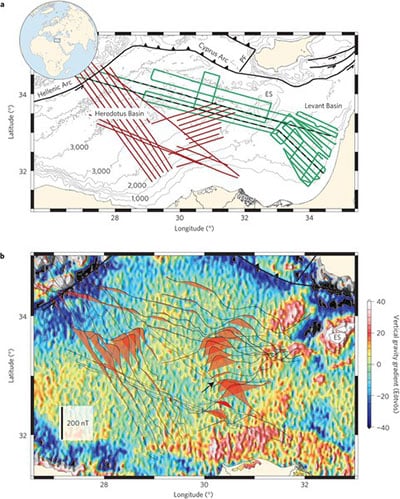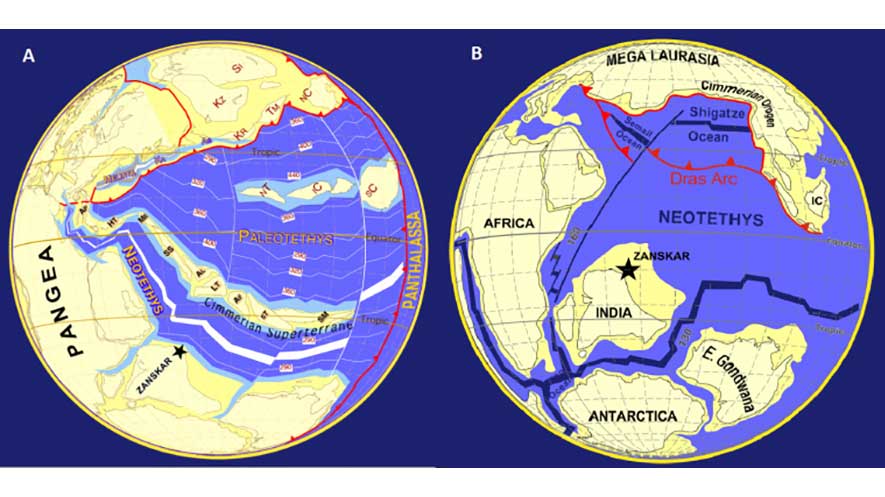Thus, remnants of ancient (>200 Ma) oceans are limited mostly to fragments preserved on land as altered assemblages. However, some locations such as the far northwest Pacific still have some ancient oceanic crust that has not been fully subducted.
It has been suggested that the remains of the Neo-Tethys Ocean have been preserved in the crust beneath the eastern Mediterranean Sea. The Neo-Tethys Ocean is thought to have formed during the Triassic Period (~250 Ma) when the Pangaea Supercontinent began to break apart (Figure 1a). The new ocean (Neo-Tethys) began forming when rift opened along the northern continental shelf of Southern Pangaea (Gondwana). Over the next 60 million years, that piece of shelf (Cimmera) traveled north, pushing the floor of the older Paleo-Tethys Ocean under the eastern end of Northern Pangaea (Laurasia). The Neo-Tethys Ocean was thus formed between Cimmera and Gondwana (Figure 1b), over where the older Paleo-Tethys Ocean used to be.
During the Jurassic Period (150 Ma), the continents Laurasia and Gondwana began drifting apart, creating an extension of the Neo-Tethys Ocean between them that today is the part of the Atlantic Ocean. In its widest extension, the Neo-Tethys Ocean was part of a continuous oceanic belt running around the Earth just north of the Equator. With this, ocean currents at the time of the Early Cretaceous moved quite differently compared to their present patterns; an equatorial current could circle the globe without continents getting in the way.
Today, India, Pakistan, Indonesia, and the Indian Ocean cover the area once occupied by the Tethys Oceans, and Turkey, Iraq, and Tibet sit on Cimmeria. What was once the western arm of the Tethys was the ancestor of the present-day Mediterranean Sea. Most of the floor of the Tethys Oceans disappeared under Cimmeria and Laurasia. But could a piece of it still be around, and what could it tell us about ancient oceans?
 Figure 2(a): Tectonic map of the eastern Mediterranean. Green and red lines show the tracks of research cruises to collect data. (b) Magnetic anomalies superimposed on a gravity gradient map derived from satellite altimetry. The magnetic anomalies are plotted along tracks. Red shading indicates positive anomalies. Credit: Roi Granot/Nature Geoscience.
Figure 2(a): Tectonic map of the eastern Mediterranean. Green and red lines show the tracks of research cruises to collect data. (b) Magnetic anomalies superimposed on a gravity gradient map derived from satellite altimetry. The magnetic anomalies are plotted along tracks. Red shading indicates positive anomalies. Credit: Roi Granot/Nature Geoscience.
Magnetic Anomolies Can Tell the Past
Because oceanic crust is relatively young, our knowledge of ancient oceanic lithospheres is murky. Luckily, the eastern Mediterranean Sea may preserve the southern margin of the Neo-Tethyan ocean. However, an exceptionally thick sedimentary cover and a lack of accurate data have led to contradicting views about how old it may be, and whether it is ancient oceanic or continental crust.
Roi Granot of the Ben-Gurion University of the Negev in Israel analyzed 7,000 km of magnetic anomaly profiles collected with a sea-surface towed system, and used a satellite-derived gravity anomaly field to highlight deeply buried crustal structures. Magnetic anomalies are often used to determine the age of ancient seafloor crust, because as oceanic crust forms at spreading centers, the new sea floor aligns with the orientation of Earth’s magnetic field at the time. Continental crust does not have these distinct features.
Granot’s results showed a sequence of lineated magnetic anomalies, which imply that the crust is indeed oceanic (Figure 2). He then used the shape of the anomalies to narrow down the timing of crustal formation to a range of about 365-255 Ma. Based on a segment of magnetized crust (a chron) that had “normal” orientation, he could further correlate its age to a time before Earth’s geomagnetic field entered the reversed Kiaman Superchron (262-318 Ma). Additionally, long (>2 Myr) normal geomagnetic chrons, within the range of the possible crustal ages, are known to have occurred only before 316 Ma. Thus, Granot infers that the estimated age of the crust in question is 340 ± 25 Ma (early – middle Carboniferous).
This is a surprising result, considering previous estimates of the formation of the Neo-Tethys were about 250 Ma. These results could suggest that the Neo-Tethys Ocean came into being at least 50 Ma earlier than previously predicted, which, in turn, suggests that the Pangaea Supercontinent had already started to disperse before it completed its formation at around 320 Ma. Alternatively, this crust may be related to a prior ocean, the older Paleo-Tethys spreading system. These different tectonic scenarios could be tested with further well-dated palaeomagnetic data constraining the motions of the different tectonic blocks surrounding the eastern Mediterranean. Why is this all important? Paleontologists have found the ancient Tethys Oceans particularly fascinating because many of the world’s sea shelves were found around its margins for such an extensive length of time, preserving marine and estuarian fossils. Now, as we continue to delve into ancient plate tectonics and paleoceanography, physical oceanographers and geologists can not only help paleontologists understand what conditions were like for those creatures, but also may find this area increasingly important to understanding our Earth’s oldest secrets.
Paper: Granot, R., 2016. Palaeozoic oceanic crust preserved beneath the eastern Mediterranean. Nature Geoscience, v.9: 701–705
By: Zoe Gentes, Knauss Marine Policy Fellow

